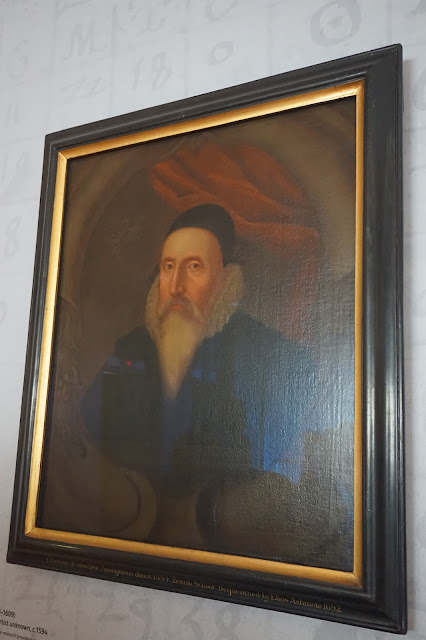 |
| Crystal Ball of John Dee |
On the other hand, in mid-1500s England, mathematics could be considered to be magic, and Dee was arrested in 1555 for "calculating."
Dee was closely associated with the court of Queen Elizabeth I. He was an adviser to her and may have acted as a spy for her as well. His mathematical work was used by navigators of the time. He also made suggestions regarding calendar reform to Elizabeth, and they were excellent suggestions, better than what was proposed by Pope Gregory XIII, but the Archbishop of Canterbury was opposed, so these were not put into place. Dee was particularly known for his work in geometry. He wrote a long preface to the first English edition (1570) of Euclid's Elements - a book that was issued with sheets of templates for three-dimensional diagrams to be cut out and pasted in (i.e. a pop-up book!). He lectured in Paris on Euclid's Elements where people flocked to his lectures!
 |
| John Dee |
In his diary, Dee claimed that the crystal pictured above was given to him by the angel Uriel in November 1582. He used the crystal for predicting the future by looking for symbols or "ghosts" of people in the stone. He, and his friend Edward Kelley, also claimed that Uriel instructed them about how to make the philosopher's stone.
The above may have been Dee's scrying mirror, something he may have used for conjuring visions, calling spirits, or divination. Dee was so high in Elizabeth's favor - at least early-on - that she actually visited his home in Mortlake. She is said to have viewed herself in his mirror and to have been pleased at what she saw.
Dee spent a great deal of time amassing a personal library. He was abroad a great deal collecting books (and probably spying for Elizabeth at the same time). However, during one of his travels, his home and library were ransacked, many or most of his books were taken, along with his instruments. This exhibition, which is being put on by the Royal College of Physicians, is titled Scholar, Courtier, Magician: The Lost Library of John Dee. I should have paid more attention to the details - no one knows who plundered Dee's library. I believe some of his books ended up in the hands of one of his students eventually and then most of them found their way into someone else's library - a library that was eventually donated to the Royal College of Physicians who is now displaying it along with many personal items, such as the mirror and crystals pictured above.
Dee's life ended in poverty and obscurity. He was never able to regain his fortunes after the plundering of his home, and he had fallen out of favor in court because of his increasingly deep explorations into the occult. He was during his lifetime, and even more so since his death, a cult figure. He is thought to have inspired Shakespeare's conjuror Prospero in The Tempest, Christopher Marlowe's Dr. Faustus, and Ben Johnson's The Alchemist. Today there are works of art and literature - as well as a comic book character and a rock opera - based on him. To fill in details of my sabbatical experience, I'm reading a recent novel based on his life - having to do with a fictional search for the bones of King Arthur in Glastonbury at the behest of Queen Elizabeth I.
An interesting character indeed!





No comments:
Post a Comment